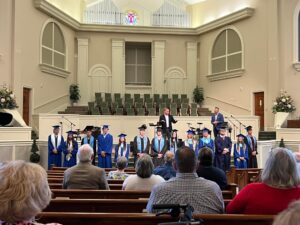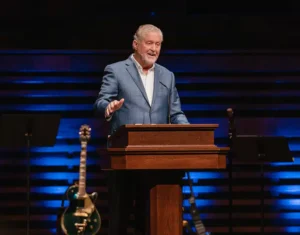
WASHINGTON (BP)–Speaking one week after a Senate deal averted a showdown over judicial filibusters, President Bush said May 31 that he intends to fill any future Supreme Court vacancy with someone who fits his judicial philosophy.
On a separate issue, he once again said he would veto an embryonic stem cell bill that recently passed the House of Representatives.
Holding a news conference days after a group of 14 senators reached a much-publicized compromise, Bush was asked about the process he would use in nominating someone to the high court.
Although there is no vacancy now, many observers believe a seat could come open this summer, perhaps with Chief Justice William Rehnquist stepping down.
“I look forward to talking to members of the Senate about the Supreme Court process, to get their opinions,” Bush said. “… But obviously, I told the American people I would find people of a certain temperament that would serve on the bench, and I intend to do that. But we will consult with the Senate.”
The agreement by the 14 senators — seven Democrats and seven Republicans — encouraged the White House to consult more with the Senate in nominating justices to the federal court.
Democrats have used the filibuster over the past four years to block nearly one-fifth of Bush’s appeals court nominees. The compromise will allow most of the contested nominees to receive a vote. In return, Republicans vowed not to support a procedural tactic — known by some as the “nuclear option” — that would ban judicial filibusters altogether. GOP leaders insist, though, that the option remains a possibility if Democrats don’t keep their end of the deal.
Christian conservatives hope Bush’s nominees to the Supreme Court will help roll back decades of socially liberal rulings, including ones on abortion, religious freedom and homosexuality.
If an opening does occur, Bush said, he will “spend a lot of time reviewing the records of a variety of people and looking at their opinions and their character.”
In the past he has named Supreme Court Justices Antonin Scalia and Clarence Thomas — two of the court’s top conservatives — as those with the judicial philosophy he most admires.
The compromise by the 14 senators allowed future filibusters only under “extraordinary circumstances.”
“I guess [the phrase ‘extraordinary circumstances’] was vague enough for people to interpret the agreement the way they want to interpret it,” Bush said before adding, “… I don’t know what that means. I guess we’re about to find out, when it comes to other appellate judges.”
Bush also was asked his views on fertility clinics that create more embryos than couples want. The House of Representatives passed a bill May 24 that would repeal Bush’s stem cell policy and would provide federal funding for new embryonic stem cell research. Bush says he will veto it if it passes the Senate.
Bush said adoption of the frozen embryos is an option. He noted he met with families who had given birth to babies that were adopted as frozen embryos. The program — known as Snowflake Embryo Adoptions — demonstrates there is an “alternative to the destruction of life,” Bush said.
Bush’s policy, implemented in 2001, allows federal funding on embryonic stem cell lines created up to the time of his announcement. But it bans federal funding on new embryonic stem cell research, which destroys the tiny humans. Privately funded embryonic stem cell research still is allowed.
“The stem cell issue … is really one of federal funding,” Bush said. “That’s the issue before us — … whether or not we use taxpayers’ monies to destroy life in order to hopefully find cure[s] for terrible diseases. And I have made my position very clear on that issue, and that is I don’t believe we should [do it]…. And I stand strong on that, to the point where I’ll veto the bill as it now exists.”
Bush does support non-embryonic stem cell research, which up to this point has shown much more success than has embryonic stem cell research. Supporters of non-embryonic stem cell research — such as that performed on umbilical cord blood — note that non-embryonic stem cells have resulted in approximately 60 successful treatments, while thus far embryonic stem cells have resulted in no such treatments.
Bush pointed out that federal funding is ongoing on the embryonic stem cells lines that existed before his 2001 decision was made.
“There’s been over 600 experiments based upon the stem cells lines that existed prior to my decision,” he said. “There’s another 3,000 potential experiments they tell me that can go forward. There’s a lot of research going on on adult stem cell research. We’ve got an ethics panel that is in place that will help us hopefully develop ways to continue to figure out how to meet the demands of science and the need for ethics so that we can help solve some of these diseases.
“I understand the folks that are deeply concerned for a child who might have juvenile diabetes. I know that moms and dads across the country are in agony about the fate of their child. And my message to them is that there is research going on, and hopefully we’ll find the cure. But at the same time it’s important in a society to balance ethics and science.”
–30–















